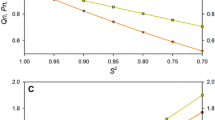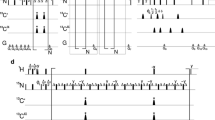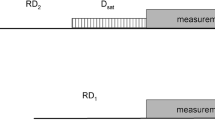Abstract
Protein backbone dynamics is often characterized using model-free analysis of three sets of 15N relaxation data: longitudinal relaxation rate (R 1), transverse relaxation rate (R 2), and 15N–{H} NOE values. Since the experimental data is limited, a simplified model-free spectral density function is often used that contains one Lorentzian describing overall rotational correlation but not one describing internal motion. The simplified spectral density function may be also used in estimating the overall rotational correlation time, by making the R 2/R 1 largely insensitive to internal motions, as well as used as one of the choices in the model selection protocol. However, such approximation may not be valid for analysis of relaxation data of large proteins recorded at high magnetic field strengths since the contribution to longitudinal relaxation from the Lorentzian describing the overall rotational diffusion of the molecule is comparably small relative to that describing internal motion. Here, we quantitatively estimate the errors introduced by the use of the simplified spectral density in model-free analysis for large proteins at high magnetic field strength.





Similar content being viewed by others
References
Abu-Abed M, Millet O, MacLennan DH, Ikura M (2004) Probing nucleotide-binding effects on backbone dynamics and folding of the nucleotide-binding domain of the sarcoplasmic/endoplasmic-reticulum Ca2+-ATPase. Biochem J 379:235–242
Andrec M, Montelione GT, Levy RM (1999) Estimation of dynamic parameters from NMR relaxation data using the Lipari-Szabo model-free approach and Bayesian statistical methods. J Magn Reson 139:408–421
Barchi JJJ, Grasberger B, Gronenborn AM, Clore GM (1994) Investigation of the backbone dynamics of the IgG-binding domain of streptococcal protein G by heteronuclear two-dimensional 1H-15N nuclear magnetic resonance spectroscopy. Protein Sci 3:15–21
Bouamr F, Cornilescu CC, Goff SP, Tjandra N, Carter CA (2005) Structural and dynamics studies of the D54A mutant of human T cell leukemia virus-1 capsid protein. J Biol Chem 280:6792–6801
Bruschweiler R (2003) New approaches to the dynamic interpretation and prediction of NMR relaxation data from proteins. Curr Opin Struct Biol 13:175–183
Campbell AP, Spyracopoulos L, Irvin RT, Sykes BD (2000) Backbone dynamics of a bacterially expressed peptide from the receptor binding domain of Pseudomonas aeruginosa pilin strain PAK from heteronuclear 1H-15N NMR spectroscopy. J Biomol NMR 17:239–255
Cavanagh J, Fairbrother WJ, Palmer AG, Skelton NJ (1996) Protein NMR spect. Academic Press, San Diego
Chandrasekhar I, Clore GM, Szabo A, Gronenborn AM, Brooks BR (1992) A 500 ps molecular dynamics simulation study of interleukin-1 beta in water. Correlation with nuclear magnetic resonance spectroscopy and crystallography. J Mol Biol 226:239–250
Chang SL, Tjandra N (2005) Temperature dependence of protein backbone motion from carbonyl 13C and amide 15N NMR relaxation. J Magn Reson 174:43–53
Chen J, Brooks CLI, Wright PE (2004) Model-free analysis of protein dynamics: assessment of accuracy and model selection protocols based on molecular dynamics simulation. J Biomol NMR 29:243–257
Clore GM, D riscoll PC, Wingfield PT, Gronenborn AM (1990) Analysis of the backbone dynamics of interleukin-1 beta using two-dimensional inverse detected heteronuclear 15N-1H NMR spectroscopy. Biochemistry 29:7387–7401
Coles M, Diercks T, Muehlenweg B, Bartsch S, Zoelzer V, Tschesche H, Kessler H (1999) The solution strucuture and dynamics of human neutrophil gelatinase-associated lipocalin. J Mol Biol 289:139–157
d’Auvergne EJ, Gooley PR (2003) The use of model selection in the model-free analysis of protein dynamics. J Biomol NMR 25:25–39
Dayie KT, W agner G, Lefevre JF (1996) Theory and practice of nuclear spin relaxation in proteins. Annu Rev Phys Chem 47:243–282
Ding Z, Lee GI, Liang X, Gallazzi F, Arunima A, Van Doren SR (2005) PhosphoThr peptide binding globally rigidifies much of the FHA domain from Arabidopsis receptor kinase-associated protein phosphatase. Biochemistry 44:10119–10134
Farrow NA, Muhandiram R, Singer AU, Pascal SM, Kay CM, Gish G, Shoelson SE, Pawson T, Forman-Kay JD, Kay LE (1994) Backbone dynamics of a free and phosphopeptide-complexed Src homology 2 domain studied by 15N NMR relaxation. Biochemistry 33:5984–6003
Fausti S, Weiler S, Cuniberti C, Hwang KJ, No KT, Gruschus JM, Perico A, Nirenberg M, Ferretti JA (2001) Backbone dynamics for the wild type and a double H52R/T56W mutant of the vnd/NK-2 homeodomain from Drosophila melanogaster. Biochemistry 40:12004–12023
Fushman D, Cowburn D (2001) Nuclear magnetic resonance relaxation in determination of residue-specific N-15 chemical shift tensors in proteins in solution: protein dynamics, structure, and applications of transverse relaxation optimized spectroscopy. Nuclear Magnet Reson Biol Macromol Pt B:109–126
Fushman D, Tjandra N, Cowburn D (1999) An approach to direct determination of protein dynamics from N-15 NMR relaxation at multiple fields, independent of variable N-15 chemical shift anisotropy and chemical exchange contributions. J Am Chem Soc 121:8577–8582
Fushman D, Weisemann R, Thuring H, Ruterjans H (1994) Backbone dynamics of ribonuclease-T1 and its complex with BA 2’GMP studied by 2-dimensional heteronuclear NMR-spectroscopy S. J Biomol NMR 4:61–78
Garcia FL, Szyperski T, Dyer JH, Choinowski T, Seedorf U, Hauser H, Wuthrich K (2000) NMR structure of the sterol carrier protein-2: implications for the biological role. J Mol Biol 295:595–603
Gong Q, Ishima R (2007) 15N-{1H} NOE experiment at high magnetic field strengths. J Biomol NMR 37:147–157
Grzesiek S, Bax A (1993) The importance of not saturating H2O in protein NMR – application to sensitivity enhancement and NOE measurements. J Am Chem Soc 115:12593
Idiyatullin D, Daragan VA, Mayo KH (2003) (NH)-N-15 backbone dynamics of protein GB1: comparison of order parameters and correlation times derived using various “model-free" approaches. J Phys Chem B 107:2602–2609
Igumenova TI, Frederick KK, Wand AJ (2006) Characterization of the fast dynamics of protein amino acid side chains using NMR relaxation in solution. Chem Rev 106:1672–1699
Ilangovan U, Ding W, Zhong Y, Wilson CL, Groppe JC, Trbovich JT, Zuniga J, Demeler B, Tang Q, Gao G, Mulder KM, Hinck AP (2005) Structure and dynamics of the homodimeric dynein light chain km23. J Mol Biol 352:338–354
Ishima R, Nagayama K (1995) Protein backbone dynamics revealed by quasi spectral density function analysis of amide N-15 nuclei. Biochemistry 34:3162–3171
Ishima R, Torchia DA (2000) Protein dynamics from NMR. Nat Struct Biol 7:740–743
Jarymowycz VA, Stone MJ (2006) Fast time scale dynamics of protein backbones: NMR relaxation methods, applications, and functional consequences. Chem Rev 106:1624–1671
Kay LE (2005) NMR studies of protein structure and dynamics. J Magn Reson 173:193–207
Kay LE, Torchia DA, Bax A (1989) Backbone dynamics of proteins as studied by nitrogen-15 inverse detected heteronuclear NMR spectroscopy: application to staphylococcal nuclease. Biochemistry 28:8972–8979
Korchuganov DS, Gagnidze IE, Tkach EN, Schulga AA, Kirpichnikov MP, Arseniev AS (2004) Determination of protein rotational correlation time from NMR relaxation data at various solvent viscosities. J Biomol NMR 30:431–442
Korzhnev DM, Orekhov VY, Arseniev AS (1997) Model-free approach beyond the borders of its applicability. J Biomol NMR 127:184–191
Kroenke CD, Loria JP, Lee LK, Rance M, Palmer AG (1998) Longitudinal and transverse H-1-N-15 dipolar N-15 chemical shift anisotropy relaxation interference: unambiguous determination of rotational diffusion tensors and chemical exchange effects in biological macromolecules. J Am Chem Soc 120:7905–7915
Lee AL, Wand AJ (1999) Assessing potential bias in the determination of rotational correlations times of proteins by NMR. J Biomol NMR 13:101–112
Lee LK, Rance M, Chazin WJ, Palmer AGr (1997) Rotational diffusion anisotropy of proteins from simultaneous analysis of 15N and 13C alpha nuclear spin relaxation. J Biomol NMR 9:287–298
Lefevre JF, Dayie KT, Peng JW, Wagner G (1996). Internal mobility in the partially folded DNA binding and dimerization domains of GAL4: NMR analysis of the N-H spectral density functions. Biochemistry 35:2674–2686
Li YC, Montelione GT (1994) Overcoming solvent saturation-transfer artifacts in protein Nmr at neutral Ph – application of pulsed-field gradients in measurements of H-1 N-15 overhauser effects. J Magnet Reson Ser B 105:45–51
Lipari G, Szabo A (1982) Model-free approach to the interpretation of nuclear magnetic resonance relaxation in macromolecules. 1. Theory and range of validity. J Am Chem Soc 104:4546–4559
Mandel AM, Akke M, Palmer AG (1995) Backbone dynamics of Escherichia coli ribonuclease Hi – correlations with structure and function in an active enzyme. J Mol Biol 246:144–163
Meirovitch E, Shapiro YE, Liang ZC, Freed JH (2003) Mode-coupling SRLS versus mode-decoupled model-free N-H bond dynamics: mode-mixing and renormalization. J Phys Chem B 107:9898–9904
Palmer AG 3rd (2001) Nmr probes of molecular dynamics: overview and comparison with other. Annu Rev Biophys Biomol Struct 30:129–155
Palmer AG, Rance M, Wright PE (1991) Intramolecular motions of a zinc finger DNA-binding domain from Xfin characterized by proton-detected natural abundance 13C heteronuclear NMR spectroscopy. J Am Chem Soc 113:4371–4380
Pawley NH, Wang C, Koide S, Nicholson LK (2001) An improved method for distinguishing between anisotropic tumbling and chemical exchange in analysis of 15N relaxation parameters. J Biomol NMR 20:149–165
Pelupessy P, Ravindranathan S, Bodenhausen G (2003) Correlated motions of successive amide N–H bonds in proteins. J Biomol NMR 25:265–280
Peng JW, Wagner G (1995) Frequency spectrum of NH bonds in eglin c from spectral density mapping at multiple fields. Biochemistry 34:16733–16752
Pfeiffer S, Fushman D, Cowburn D (2001) Simulated and NMR-derived backbone dynamics of a protein with significant flexibility: a comparison of spectral densities for βARK1 PH domain. J Am Chem Soc 123:3021–3026
Philippopoulos M, Mandel AM, Palmer AGr, Lim C (1997) Accuracy and precision of NMR relaxation experiments and MD simulations for characterizing protein dynamics. Proteins 28:481–493
Redfield C (2004) Using nuclear magnetic resonance spectroscopy to study molten globule states of proteins. Methods Mol Biol 34:121–132
Renner C, Schleicher M, Moroder L, Holak TA (2002) Practical aspects of the 2D N-15-{H-1}-NOE experiment. J Biomol NMR 23:23–33
Savard PY, Gagne SM (2006) Backbone dynamics of TEM-1 determined by NMR: evidence for a highly ordered protein. Biochemistry 45:11414–11424
Schneider DM, Dellwo MJ, Wand AJ (1992) Fast internal main-chain dynamics of human ubiquitin. Biochemistry 31:3645–3652
Schramm HJ, Nakashima H, Schramm W, Wakayama H, Yamamoto N (1991) HIV-1 reproduction is inhibited by peptides derived from the N- and C-termini. Biochem Biophys Res Commun 179:847–851
Sheinerman FB, Brooks CLr (1997) A molecular dynamics simulation study of segment B1 of protein G. Proteins 29:193–202
Skelton NJ, Palmer AG, Akke M, Kordel J, Rance M, Chazin WJ (1993) Practical aspects of 2-dimensional proton-detected N-15 spin relaxation measurements. J Magnet Reson Ser B 102:253–264
Spyracopoulos L (2006) A suite of mathematica notebooks for the analysis of protein main chain (15)N NMR relaxation data. J Biomol NMR 36:215–224
Stone M, Chandrasekhar K, Holmgren A, Wright PE, Dyson HJ (1993) Abstract comparison of backbone and tryptophan side-chain dynamics of reduced and oxidized Escherichia coli thioredoxin using 15N NMR relaxation measurements. Biochemistry 32:426–435
Tjandra N, Kuboniwa H, Ren H, Bax A (1995) Rotational dynamics of calcium-free calmodulin studied by 15N-NMR relaxation measurements. Eur J Biochem 230:1014–1024
Yuan P, Marshall VP, Petzold GL, Poorman RA, Stockman BJ (1999) Dynamics of stromelysin/inhibitor interactions studied by 15N NMR relaxation measurements: comparison of ligand binding to the S1-S3 and S1-S3 subsites. J Biomol NMR 15:55–64
Zhuravleva AV, Korzhnev DM, Kupce E, Arseniev AS, Billeter M, Orekhov VYY (2004) Gated electron transfers and electron pathways in azurin: a NMR dynamic study at multiple fields and temperatures. J Mol Biol 342:1599–1611
Acknowledgements
We thank Dennis Torchia and Nico Tjandra for critical reading of the manuscript. Financial support for this work was provided by University of Pittsburgh to R.I., and the NIH and the Robert A. Welch Foundation to A.H.
Author information
Authors and Affiliations
Corresponding author
Rights and permissions
About this article
Cite this article
Chang, SL., Hinck, A.P. & Ishima, R. Model-free analysis for large proteins at high magnetic field strengths. J Biomol NMR 38, 315–324 (2007). https://doi.org/10.1007/s10858-007-9171-9
Received:
Accepted:
Published:
Issue Date:
DOI: https://doi.org/10.1007/s10858-007-9171-9




